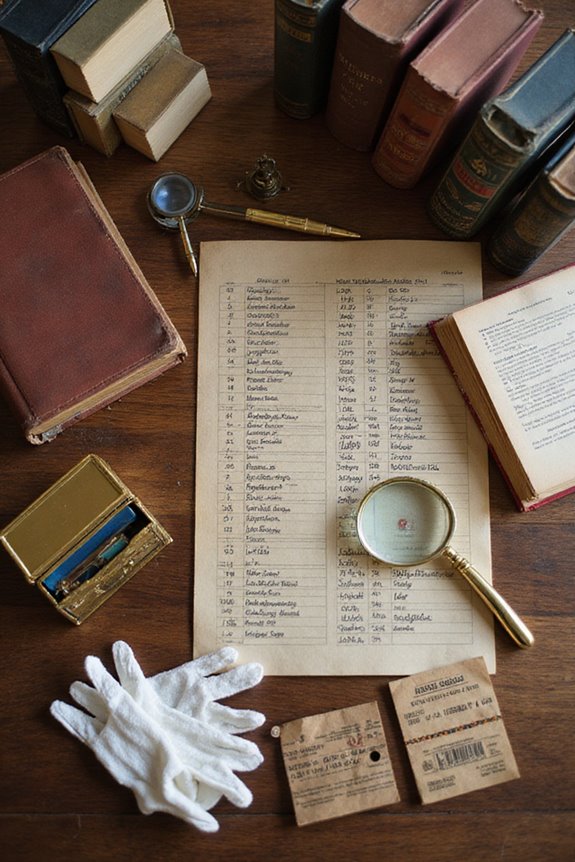We organize print collections using classification systems like Dewey Decimal and Library of Congress, which help us group books logically. Cataloging makes finding titles and authors a breeze, while ongoing evaluation of usage trends guarantees we’re meeting your interests. We also weed out outdated materials and bring in new ones to keep our shelves fresh. Plus, shared print programs help us collaborate with other libraries. Want to know more about how libraries maintain these vibrant collections?
Key Takeaways
- Libraries use classification systems like Dewey Decimal or Library of Congress to categorize print materials systematically.
- Cataloging processes create detailed records that help organize books by author, title, or topic.
- Regular circulation data analysis allows libraries to identify underutilized materials for better organization.
- Weeding involves evaluating print resources for age, relevance, and usage to maintain a dynamic collection.
- Collaboration through shared print programs reduces duplication and optimizes shelf space among participating libraries.
Understanding Library Print Collections

When we immerse ourselves in understanding library print collections, we quickly realize that they’re like the backbone of many libraries, supporting a wealth of knowledge and resources. At the heart of this organization are classification systems, like the Dewey Decimal or Library of Congress systems, which help us categorize books effectively. These systems allow us to locate materials based on subjects, making the library less intimidating. Meanwhile, cataloging processes create detailed records for each print item, sorting them by author, title, or topic. Curious about a specific book? Look in the catalog! By mastering these tools, we can navigate our library’s print collections with ease, ensuring we find the information we need, while also appreciating the depth of resources available to us.
Factors Influencing Collection Management

As we explore the factors influencing collection management, it becomes clear that understanding how print collections are used is key to optimizing them. By analyzing circulation data and usage trends, we can gauge which books are popular and which sit collecting dust. For instance, comparing the circulation rates to holdings through collection evaluation metrics, like the use factor, helps us pinpoint underutilized materials that might need a gentle nudge into the spotlight. Additionally, looking at content-based factors, such as subject area, allows us to tailor our collection to the interests of our patrons. So, let’s keep our collections lively! Regular assessment and attention to circulation patterns empower us to curate an enjoyable and relevant resource for everyone.
Acquisition and Weeding Processes

Understanding the acquisition and weeding processes is crucial for keeping our library collections fresh and relevant. We start by selecting materials based on our collection development policies, often benefiting from approval plans that streamline acquisitions and help us maintain strong vendor relationships. These plans allow us to receive shelf-ready materials, reducing our in-house prep time.
We also take fiscal management seriously; negotiating prices with vendors guarantees we stay within budget while expanding our collection. On the other hand, weeding is just as important. Regularly reviewing materials for their age, usage, and relevance helps us maintain quality, freeing up space for new acquisitions. Balancing both acquisition and weeding allows us to create a dynamic and engaging library environment for everyone.
Utilizing Shared Print Programs

Have you ever wondered how libraries manage their print collections effectively, especially with so many challenges in play? Utilizing shared print programs is one strategy we employ to tackle these hurdles. These programs allow multiple libraries to work together, guaranteeing the preservation of essential print materials through collaborative retention agreements. By committing to hold specific titles for at least ten years, we can reduce duplication and free up valuable shelf space. For instance, when we analyze usage patterns or assess the uniqueness of items, we optimize resource allocation. This also means libraries can tackle shrinking budgets and rising acquisition costs while enriching our collections with diverse scholarship. By leveraging technology, we guarantee efficient access to these shared resources, enhancing our patrons’ experience.
Tracking Usage and Measuring Value
When it comes to tracking the usage and measuring the value of print collections, it’s essential for us to employ a variety of strategies. We often use Integrated Library Systems (ILS) to systematically capture check-out data, but that only tells part of the story. Informal lending labels can help us track items in satellite collections that don’t circulate. Also, we can’t forget those non-circulation usage metrics—like browsing and reference consultations—that show the true impact of our collections. However, data challenges, such as inconsistent reporting and understanding that checkout numbers may underrepresent total usage, complicate our assessment. By combining circulation data with observations of in-library interactions, we gain a more thorough view of our print resources’ value.
Preservation and Digitization Strategies
As we assess the usage and value of our print collections, it becomes clear that preserving these resources is just as important. We employ various preservation techniques, like maintaining ideal temperature and humidity levels to slow decay. For example, a cool, stable environment with low light exposure can really help protect our collections. Additionally, we train our staff on proper handling methods to minimize damage during retrieval and shelving.
Digitization plays a vital role in our strategy. By creating digital surrogates, we provide easier access while reducing wear on fragile originals. This requires careful digital workflows and trained technicians, ensuring that we protect the integrity of the original materials during scanning. Balancing these preservation efforts helps us extend the life of our cherished print collections.
Enhancing Accessibility and Community Engagement
While we might think of libraries as just places filled with books, they’re actually vibrant community hubs designed for everyone. By providing accessible resources like large print and Braille, libraries guarantee that people with disabilities can enjoy reading too. It’s not just about books; we include video games and musical instruments to engage a wide audience. Through community partnerships, libraries can enhance their offerings, like hosting workshops with local organizations. Plus, we listen to feedback from patrons to improve services, making them even more inclusive. Let’s remember, our libraries are evolving spaces that embrace all needs. If you have ideas, share them! Together, we can improve accessibility and community engagement for everyone. Engaging sensory materials can further enhance the experience for patrons by facilitating interactive learning opportunities.
Frequently Asked Questions
How Do Libraries Decide on Shelf Arrangement for Print Collections?
When we consider shelf arrangement, we rely on effective shelf organization strategies, utilizing classification systems like Dewey Decimal. This guarantees materials are grouped logically, enhancing accessibility and making it easier for everyone to find what they need.
What Role Do Volunteers Play in Organizing Library Print Collections?
Like diligent gardeners nurturing a vibrant orchard, we embrace volunteer training to cultivate collection management. Our efforts blossom as we organize, maintain, and enrich library print collections, ensuring they flourish for all who seek knowledge within.
How Often Do Libraries Conduct Inventory Checks of Print Materials?
We find that inventory frequency varies greatly based on our library’s size and collection maintenance needs. Small libraries may complete checks quickly, while larger ones often rotate inventories to guarantee accuracy and efficiency over time.
What Technologies Assist in Locating Materials Within Library Collections?
It is understood some might think locating materials is hard, but digital catalogs and RFID systems make it easy. These technologies streamline access, allowing us to find and manage library collections efficiently, enhancing our overall experience.
How Can Users Suggest New Materials for Library Collections?
We can suggest new materials through user feedback channels like online forms or direct communication. This input drives collection development, ensuring our library evolves with community needs and remains relevant to everyone we serve.






